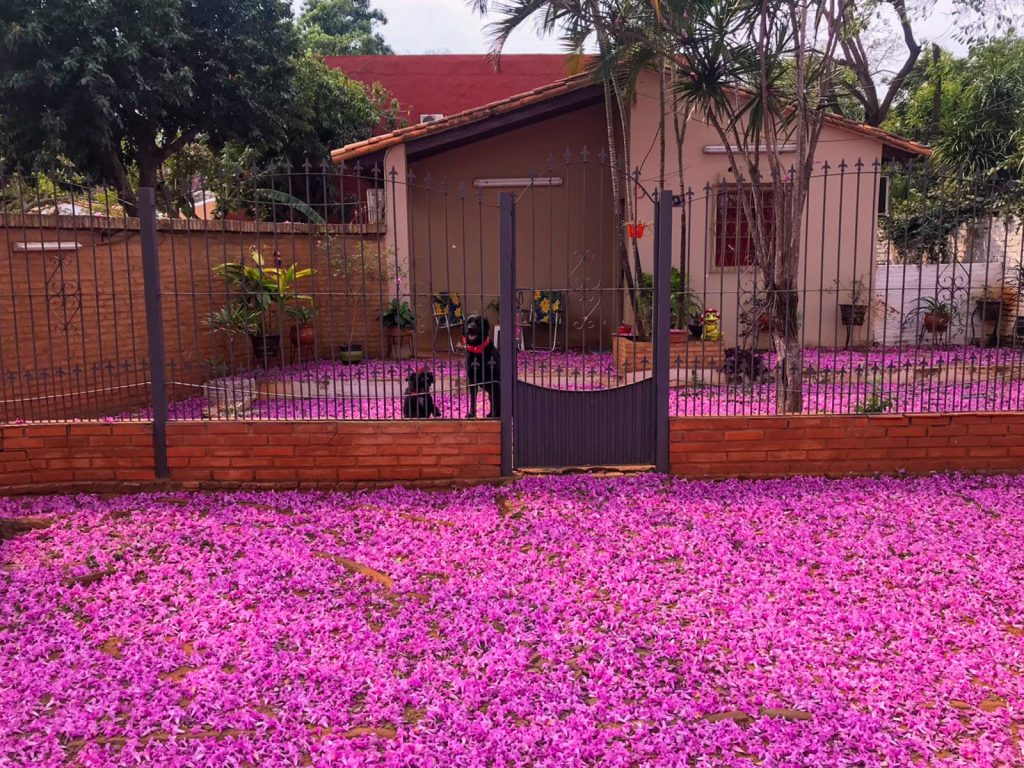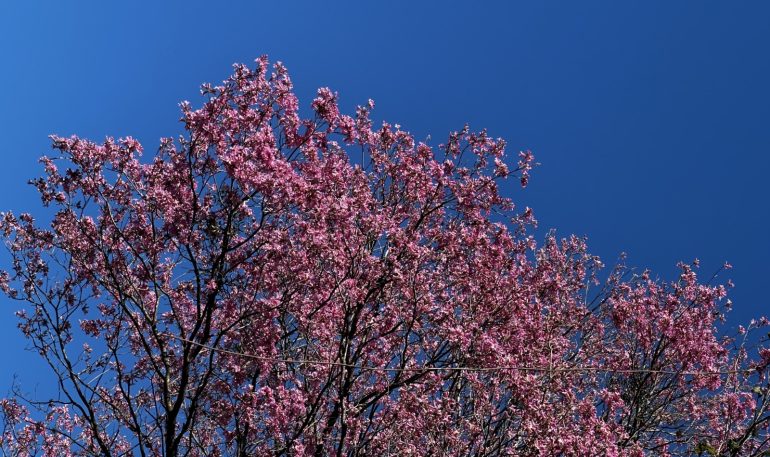August in Paraguay. One can hardly walk around its capital Asunción, or any part of the country, really, without encountering sudden explosions of pink around the famous lapacho tree. Paraguay’s national tree’s colourful flowers drift down from its branches in a gentle, circular dance, twirling slowly through the air before coming to rest on the ground. Forming a soft, magical carpet that invites to pause, and admire.
All across Paraguay, streets, parks, and rural roads are bursting into colour as the lapacho trees (Handroanthus), known locally as tajy, begin their spectacular bloom. These vibrant flowers, most famously in pink (Handroanthus impetiginosus), but also in yellow (Handroanthus ochraceus) and white (Handroanthus roseo-albus), announce the end of winter, and the promise of spring. A display so stunning that it stops pedestrians in their tracks, and turns even the most ordinary streets into works of art.
The heart of its flowering season
The blooming season typically peaks between late July and September, depending on Paraguay’s region, and weather. Because the flowers last for such a short period, there is a sense of urgency to enjoy them. This ephemeral beauty reminds those who witness it to cherish the present moment. A lesson as enduring as the tree itself.
This is why August, the heart of its flowering season, is the perfect moment to reflect on the cultural, historical, and ecological significance of Paraguay’s national tree.
Lapacho: A tree steeped in myth
For the Guaraní people, the lapacho, or tajy, carries a sacred origin. According to legend, when the time came for the Tupi and Guaraní brothers to part ways, the god Tupã Tenondé, the supreme creator god in Guaraní mythology, whose name is often translated as “the first,” or “the beginning”, gave the Guaraní a parting gift. The seeds of towering, colourful trees he had brought from Yvoga (their celestial dwelling). These trees, he said, would mark the lands they conquered, their colours, white, yellow, and pink, proclaiming their presence.
Tupã promised that the lapacho’s wood would serve them in countless ways: for canoes, tools, weapons, arrows, and homes. Ever since, the lapacho has been seen as a source of strength. Its touch believed to transmit Tupã’s power to the people and to mark the territory of the Guaraní. This is why the lapacho tree is still called “The Tree of Yvoga,” or “The tree of Tupã Tenondé”, a living emblem of resilience and belonging.

A national symbol
The lapacho tree is not just a botanical treasure; it is a national emblem. Its pink variety as Paraguay’s national tree is celebrated for its resilience and beauty. Unlike many trees that shed their leaves before flowering, the lapacho bursts into bloom when the branches are bare. Creating a striking contrast of colour against the winter sky.
This ability to flourish in the final stretch of the dry season has made it a symbol of hope and perseverance for generations. Artists like Porfirio Busto often use the lapacho as a recurring theme in their work, painting it as an iconic element of the Paraguayan landscape, capturing its vibrant presence and cultural significance.
Ecological and practical value
Beyond its beauty, the lapacho plays an important ecological role. Its flowers attract bees, butterflies, and birds, contributing to pollination and biodiversity. After blooming, the trees shed their seeds, which can be seen scattered across the ground almost everywhere outside, playing a vital role in the regeneration of the species and ensuring new trees continue to flourish. These seeds look like tiny, crumpled parchment notes sealed inside tissue-thin envelopes, each carrying the promise to reveal their beauty again the following winter.
The tree’s wood is extremely hard, known for its durability and resistance to pests, has been traditionally used in building, carpentry, and tool-making. In traditional medicine, extracts from the bark have been used by Indigenous communities for their purported healing properties, although scientific research into these effects is ongoing.
Modern-day presence
Today, lapacho trees are planted widely in cities and towns as ornamental trees, lining avenues and public squares. The trees are a favourite choice for urban landscaping, offering shade in summer and bursts of colour in late winter. In rural areas, they still stand as silent witnesses to history, often marking old settlements or paths.
In recent years, photography enthusiasts have taken to social media each lapacho season, turning the blooms into a visual celebration that connects the people in Paraguay, and abroad.


